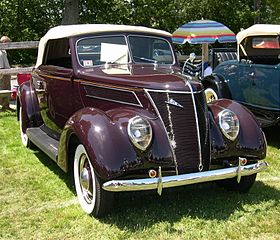1937 Ford
| Ford | |
|---|---|

1937 Ford convertible
|
|
| Overview | |
| Manufacturer | Ford |
| Production | 1937–1940 |
| Assembly |
Atlanta, Georgia Chester, Pennsylvania Chicago, Illinois Long Beach, California Dearborn, Michigan |
| Body and chassis | |
| Class | Full-size Ford |
| Body style | 2-door coupe 2-door convertible 2-door 1-ton pickup truck 2-door sedan 2-door station wagon 2-door van 4-door sedan 4-door station wagon (Woodie) 2-door coupe utility (Australia) 2-door roadster utility (Australia) |
| Layout | FR layout |
| Powertrain | |
| Engine | 136 CID (2.2 L) Flathead V8 221 CID (3.6 L) Flathead V8 |
| Dimensions | |
| Wheelbase | 2,845 mm (112.0 in) |
| Chronology | |
| Predecessor | Ford Model 48 |
| Successor | 1941 Ford |
The Ford line of cars was updated in 1937 with one major change — the introduction of an entry-level 136 CID (2.2 L) V8 in addition to the popular 221 CID (3.6 L) flathead V8. The model was a refresh of its predecessor, the Model 48 (itself based on the Model 40A), and was the company's main product. It was redesigned more thoroughly in 1941. At the start of production, it cost $850. The Ford Line bore several model numbers during this period: For domestic 1937 production in the United States Ford Model Numbers for 85 hp V-8 equipped cars was Model 78 and 60 hp V-8 cars was Model 74. Models 81A and 82A in 1938, and Models 91A and 92A in 1939.
The 1937 Ford featured a more rounded look with fine horizontal bars in the convex front and hood-side grilles. The front grille was V-shaped, rather than following the fenders into a pentagon shape, as on the 1936 model. Faired-in headlights were a major modernization found on both the Standard and DeLuxe trim versions, though much of the rest of the design was shared between Ford's two lines. A larger water pump was used to help aid in cooling. 'Slantback' sedans gained a rear trunk door, though space was limited, and 'Trunkback' versions continued gaining sales. The station wagon had seating for eight passengers. A 4-door "convertible sedan" with roll up windows was offered in small numbers in the DeLuxe series.
The 1938 recession hurt sales, as did Ford's continuing of the 1937 cars, including most body panels. 1938 DeLuxe models were differentiated with a heart-shaped grille, though standard models retained the 1937 look. The fading Slantback sedan design was cancelled for good. Only a V8 was offered, either a 60 hp V8 or an 85 hp V8. A new dash was used, with recessed controls for safety.
The 1938 trucks were finally updated, having continued with 1935 looks. Changes included a vertical oval grille and substantial fenders and bumpers.
The Ford's look was again modernized for 1939 — the Deluxe used a low pointed grille with heavier vertical slats, while the standard Ford had a higher grille with horizontal dividers. The headlights (the example illustrated has been converted to '40 Ford sealed beam headlamps - '39s used bulb and reflector lamps, the last year for these) were moved farther apart, now sitting almost in front of the wheels. The side grilles and louvers were removed in favor of chrome strips on Deluxe models. The "alligator" hood opened deep from the top of the grille back, eliminating the side panels found on previous models.
...
Wikipedia
